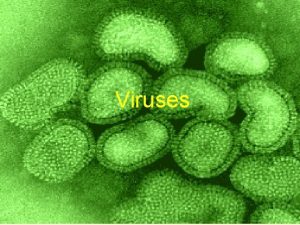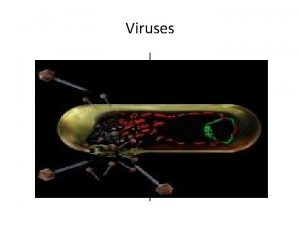Viruses Viruses are not classified in a kingdom







- Slides: 7

Viruses • Viruses are not classified in a kingdom. • Viruses are submicroscopic, filterable, infectious agents. • Viruses are too small to be seen with a light microscope and can be seen only with an electron microscope. • Viruses are obligate intracellular parasite. They must have a host (another living organism) to be able to reproduce.

• Viruses contain DNA OR RNA enclosed in a protein coat ( called Capsid ). Capsids are built from large numbers of protein subunits called CAPSOMERES. Some viruses covered by a membranous envelope. • Viruses are widely distributed in nature and have been isolated from every eukaryotic and prokaryotic organism. Based on their host specificity, viruses are divided into general categories, such as bacterial viruses ( bacteriophages ), plant viruses, and animal viruses.

Shapes of Viruses a. Helical Viruses : consist of nucleic acid surrounded by a hollow protein cylinder or capsid and possessing a helical structure (e. g. Tobacco mosaic virus (TMV)). Transmission Electron Micrograph (TEM ) of Tobacco Mosaic Virus

b. Polyhedral ( Icosahedral ) Viruses : consist of nucleic acid surrounded by a polyhedral (many-sided) shell or capsid, usually in the form of an icosahedron (e. g. Adenovirus ). TEM of Adenovirus

c. Enveloped Viruses : consist of nucleic acid surrounded by either a helical or polyhedral core and covered by an envelope (e. g. Influenza virus (enveloped helical ). Human immunodeficiency virus (HIV)(enveloped ) polyhedral (Enveloped Helical Virus) TEM of an Influenza A Virus

(Enveloped Polyhedral Virus) TEM of HIV-1 (The nucleocapsid (arrows) can be seen within the envelope)

d. Complex Viruses : They are pleomorphic (irregular shaped) have helical and polyhedral forms (e. g. Bacteriophage ), OR have complex structures (e. g. Poxviruses). Bacteriophage Electron Micrograph of Coliphage T 4













